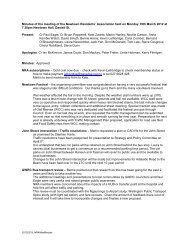Draft Town Belt Management Plan - Wellington City Council
Draft Town Belt Management Plan - Wellington City Council
Draft Town Belt Management Plan - Wellington City Council
Create successful ePaper yourself
Turn your PDF publications into a flip-book with our unique Google optimized e-Paper software.
What remained of the original <strong>Town</strong> <strong>Belt</strong> (approximately 429.5 ha) was transferred to the <strong>City</strong> of<br />
<strong>Wellington</strong> 94 . The 1873 Deed of conveyance set out the terms upon which the <strong>Council</strong>, as trustee of<br />
the land, was to administer it. In particular, the <strong>Council</strong> was to hold the land "to be forever<br />
hereafter used and appropriated as a public recreation ground for the inhabitants of the <strong>City</strong> of<br />
<strong>Wellington</strong> ... but without any power ... to alienate or dispose of the same ...” The Deed also<br />
allowed <strong>Town</strong> <strong>Belt</strong> land to be leased for terms of up to 42 years for “the best and most improved<br />
rent ... that may reasonably be had ...” and allowed for all revenue raised from the land to be<br />
applied in the same way as that specified in the 1871 Act.<br />
As the city grew, further areas of <strong>Town</strong> <strong>Belt</strong> land were taken for roads, education, housing and<br />
utility purposes (see section 4). The <strong>Town</strong> <strong>Belt</strong> was also gradually developed for recreation and<br />
amenity purposes (see sections 2 and 3).<br />
In 1908 the <strong>Wellington</strong> (<strong>City</strong>) <strong>Town</strong> <strong>Belt</strong> Reserves Act provided the <strong>Council</strong> with certain statutory<br />
powers to lease parts of the <strong>Town</strong> <strong>Belt</strong>. These powers were in addition to the <strong>Council</strong>'s existing<br />
powers under the <strong>Town</strong> <strong>Belt</strong> Deed. In 1911 the <strong>Wellington</strong> <strong>City</strong> Empowering and Amendment Act<br />
authorised the <strong>Council</strong> to charge for admission to sports grounds subject to certain restrictions.<br />
The <strong>Town</strong> <strong>Belt</strong>’s management was generally ad hoc until, in 1975, the <strong>Council</strong> approved the<br />
<strong>Management</strong> Policy: <strong>Wellington</strong> <strong>Town</strong> <strong>Belt</strong>. This was the first policy aimed at consistent<br />
management of the <strong>Town</strong> <strong>Belt</strong> as a whole. The six-page document was based upon policies that had<br />
been adopted over the years for managing the <strong>Town</strong> <strong>Belt</strong>.<br />
A more comprehensive management plan was approved by <strong>Council</strong> in 1994. The two-volume<br />
<strong>Wellington</strong> <strong>Town</strong> <strong>Belt</strong> <strong>Management</strong> <strong>Plan</strong> 1995 was prepared over several years, including the<br />
publication of eight background reports in 1992 (see references).<br />
In 1998, following on from policy in the management plan, the <strong>Council</strong> approved the <strong>Town</strong> <strong>Belt</strong><br />
Reinstatement Policy, which outlined <strong>Council</strong>’s approach to the recovery and reinstatement of land<br />
that had been part of the original <strong>Town</strong> <strong>Belt</strong>. Since then about 26.5 ha 95 of original <strong>Town</strong> <strong>Belt</strong> land<br />
that had been alienated has been returned to the <strong>Council</strong> (see section 4).<br />
In 2009, the Port Nicholson Block (Taranaki Whānui ki Te Upoko 0 Te Ika) Claims Settlement Act<br />
2009 came into force, signed by the Crown and the Port Nicholson Block Settlement Trust<br />
(representing descendants of tupuna of Te Atiawa, Taranaki, Ngāti Ruanui and Ngāti Tama and<br />
holding a kaitiaki role for Ngāti Mutunga). This settlement gave Port Nicholson Block Settlement<br />
Trust (PNBST) first right of refusal on some of the remaining identified sections of former <strong>Town</strong><br />
<strong>Belt</strong> still held by the Crown (see Appendix 3 also).<br />
In August 2010, a Memorandum of Understanding between PNBST and the <strong>Council</strong> was agreed, in<br />
which mana whenua indicated their wish to be more involved in the <strong>Town</strong> <strong>Belt</strong>’s future<br />
management.<br />
2. Public recreation ground<br />
The idea of setting aside open recreational space for the benefit of all citizens was a new concept in<br />
1840. There was little precedent in Britain, where urban parklands had until then been mainly the<br />
private domain of the wealthy. What uses, then, and what kind of public benefit would be<br />
appropriate for <strong>Wellington</strong>’s <strong>Town</strong> <strong>Belt</strong>?<br />
To begin with, it appears that many of the settlers saw the <strong>Town</strong> <strong>Belt</strong> as little more than a resource<br />
for firewood, building timber, quarrying and grazing (see section 4). By the 1870s, however, with<br />
<strong>Wellington</strong> a well-established town of 7000, the townspeople started to think about the leisure and<br />
94 Under the <strong>Town</strong> <strong>Belt</strong> and Basin Reserve Act 1873 (which implemented the 1871 Act).<br />
95 The 26.5ha includes the recent return, in 2012, of a further 4.5 ha of Telecom land.<br />
<strong>Draft</strong> <strong>Town</strong> <strong>Belt</strong> <strong>Management</strong> <strong>Plan</strong> October 2012<br />
209





